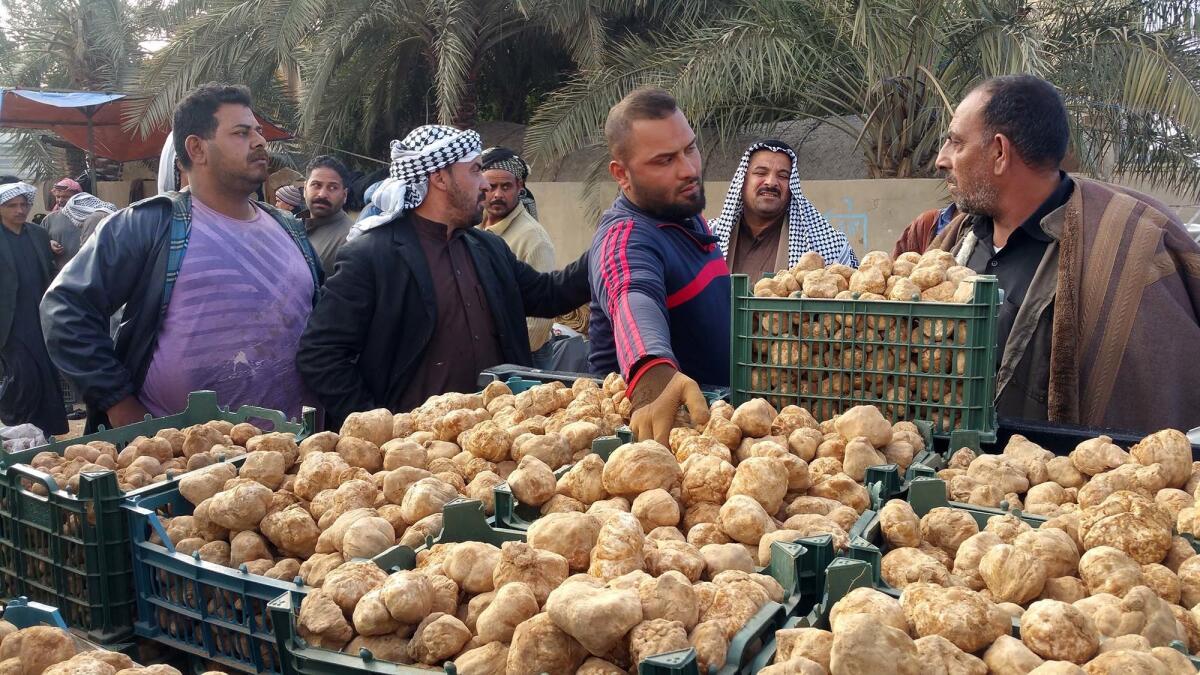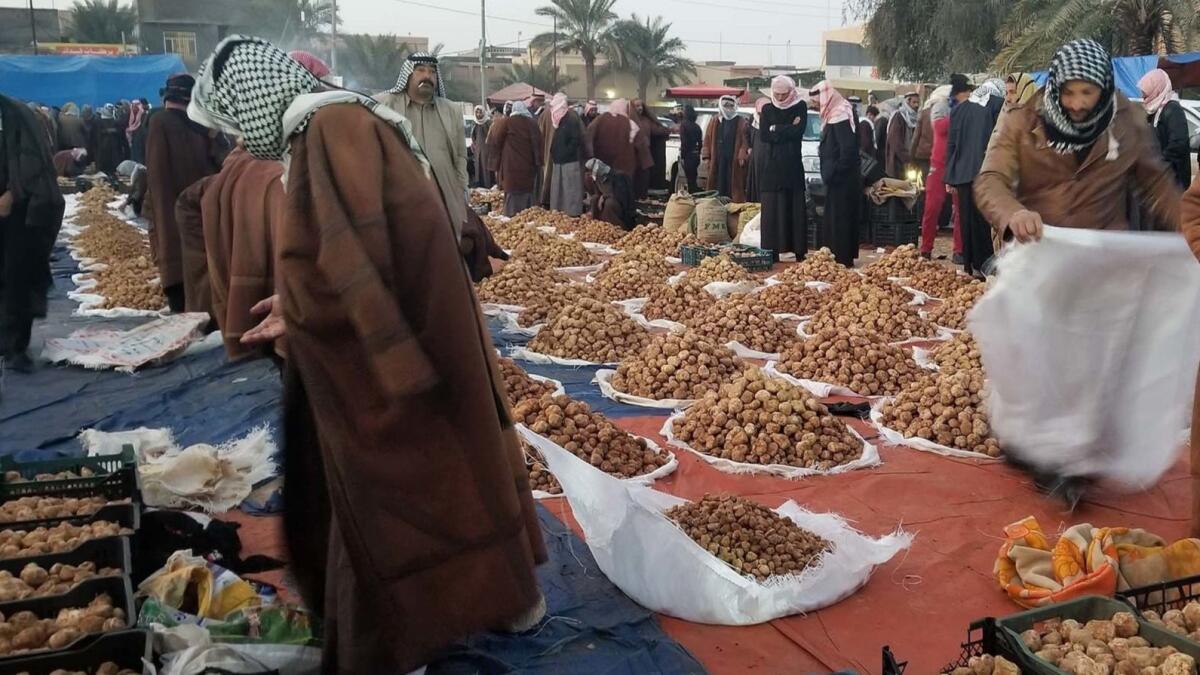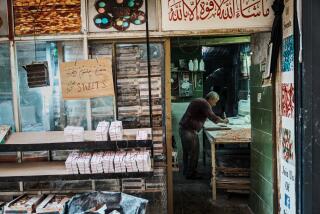Would you risk your life for a truffle? In Iraq’s desert, the hunt mixes superstition and danger

- Share via
Reporting from EKEYRAN, IRAQ — To reach Ekeyran, a place so desolate no one has bothered to put it on a map, you must abandon the bustle of Baghdad for a 173-mile jaunt to the city of Samawah, dodge camel caravans while driving over to Al Salman district — onetime home to Saddam Hussein’s harshest prison — then find a Bedouin guide to drive you two more hours deep into the uncharted desert plains near the Iraqi-Saudi border.
There, buffeted by roaring winds amid near-freezing temperatures, you too can slowly wander the barren landscape, knife in hand as you scour the ground for hours in search of the almost cruelly obscure signs hinting at your quarry.
What is it you seek? The inauspicious-looking bonne bouche known as the desert truffle.
Delicate, subtle, light yet satisfying, the desert truffle has much of the magic of its more prestigious (and rarer) European counterpart.
Because Iraqi food has all the subtlety of a stampede — consider kahi, a flaked pastry soaked in cardamon-infused syrup and clotted cream — you might think truffles would be ill-suited for such a cuisine.
You’d be wrong.
Everything about the truffle exemplifies the food-as-challenge aspect of so many ingredients in the Iraqi cookbook.
And for those who prize the desert truffle — and many do, sometimes at the risk of their lives — finding it means nothing less than a quest for treasure, one that mixes equal parts timing, superstition and danger.
First the timing. To get truffles, you need water, a fair amount of it too. But it all depends on when the first rain begins to fall.
Storms in October, November, even as late as December can herald a good harvest. Anything after, says Nofal Saleh, a mustachioed 35-year-old Bedouin, is just too late.
Saleh, who has long roamed Iraq’s south for kama, as truffle is known in Syria and Iraq, is perched one winter day in the passenger seat of a van, scanning the horizon. He’s swathed in a fur-lined abaya, a long cloak, and black-and-white kaffiyeh headdress to protect him from the elements. He points to what appears to be a random spot on the road, a signal to veer off into the desert.
As the van bumps over the harsh terrain, Saleh points to what looks like one indistinguishable area after another, yet he produces a Bedouin name for each as he marks a path heading ever closer to the Saudi border.
He counts off fingers as he begins a detailed litany of good and bad truffle seasons stretching back to 2004.
“This year the first rains fell on the 20th of October,” he says. “Pretty good.”
The storms are also where superstition comes in. Thunder and lightning are said to boost the alchemy of the truffle, a species of mushroom that grows in different types all across the arid and semiarid areas around the Middle East and zones around the Mediterranean.
The most common truffle type here is terfezia, an off-white, sponge-surfaced variety that looks rather like the rocks dotting much of the flat sand and gravel plains of Iraq’s south. That hard terrain perhaps explains the need for meteorological fireworks. Thunderclaps crack the surface of the ground like an eggshell, some say, allowing the microscopic spores to spread below the sand to flourish.

Times staff writer Nabih Bulos tracks truffles in Iraq from market to plate.
Science, however, gives a less fanciful explanation, asserting that thunderstorms generate water-soluble nitrogenous compounds. They fall with the rain and encourage growth.
Timing is also essential for the harvest. The season is fleeting, lasting a mere three months in the arid lands of Iraq and Syria. But woe be to those who dally, warns Saleh.
“By late March it becomes disgusting,” he says, wrinkling his nose at the remembrance of past truffle hunts gone bad. “It has worms in it and smells like a rotting corpse.”
Saleh continues scanning the seemingly unchanging landscape, then suddenly announces it is time to stop. He takes a moment to adjust his robes, wrapping them around himself in preparation for the elements. He opens the door, and the pressurized quiet of the cabin gives way to a growling wind.
How do you know your quarry lurks under the surface, without the benefit of truffle-sniffing dogs or pigs, which are considered unclean by Islam? With great difficulty, at least for the untrained eye.
One clue is the appearance of cracks in the soil, indicating the truffle is bulging its way toward the surface. Another is the appearance of a certain grass, called aneyd by the Bedouins here. If you see it, they say, truffles are nearby.
This observation is also borne out by research, with studies finding that desert truffles, like most of their ilk, form symbiotic relationships with certain plants and can be found close to their roots.
Unfortunately, aneyd looks almost identical to another weed.
That is one explanation as to why, after walking the uninterrupted plains, squinting at the ground, you may find yourself sans truffle.
None of this slows Asaad Jabaali, who is leaning against the wind, his robes flapping. The 23-year-old pounces on one promising spot, then another.
Once all the clues converge, he squats over the prospective site, brandishing a long kitchen knife to cut a quick circle around the spot. He works the surface with both hands to reveal the rotund outlines of the truffle. He gently works the knife at an angle underneath the truffle, and pops it out.

It gets a quick examination, with Jabaali dusting the truffle off before plopping it in a ragged-looking cloth pouch and continuing his search.
But harvesting can also be where the danger comes in, for the finest truffles are found where foragers face extreme threats. One such danger zone is the Iraqi-Saudi border, where in December, Saleh says, overzealous Iraqi guards shot what they thought was a smuggler but was actually a truffle forager.
“The truffles there are huge, the size of a pomegranate,” says Saleh, a hint of awe in his voice. “But only the guards are benefiting from them now.”
To the southeast you might encounter land mines, vestiges from the war with Iran. In the western Iraqi province of Anbar, home to the reddish, smaller iteration of desert truffle known as hargi, truffle hunters had to contend with the threat from Islamic State.
But for many, the danger is worth it, especially if market forces are on their side.
In dedicated markets stretching from Al Salman to Baghdad, hunters and merchants arrive before daybreak to peer at squat stacks of truffles piled on blankets and brimming in baskets alongside the street.

They engage in rapid-fire auctions, where quality truffles command prices as low as 8,000 Iraqi dinars per kilogram (roughly $3 a pound) all the way up to more than $10 a pound in Baghdad and nearly $25 when exported.
Depending on the area, a good forager can get anywhere from 2 to 4 kilos in a day, according to Jabaali, who shouts, straining to make himself heard above the constant roar of the wind.
Like many others here, Jabaali traveled with his family from other provinces, setting up tents for weeks on end in a collective effort to get truffles. He no doubt had in mind the story of one family that managed to sell $11,000 worth of truffles in three months — a princely sum here.
Nearby is a lone tent, pelted off-white by the sand. It houses some nine members of Jabaali’s clan, some of them even now spread out on the plains. A pickup truck awaits the haul for a trek to the market.
If you’ve found the truffle, and survived the harvest, you still have to clean it.
There are boundless theories, many contradictory, as to the best manner to clean the crevices of sand. The commonality is that each method is thankless: Nobody compliments you for doing it well, and everyone frowns if sand crunches against their teeth.
One way is to soak the truffles in ice-cold water to push the sand from the cracks, then use a toothbrush to painstakingly tease out every last bit.
Popping wheelies with the Knights of Baghdad, Iraq’s not-quite-outlaw motorcycle club »
Press too hard and you’ll bruise the skin and turn the insides to mush. Brush too lightly and your meal may not be ready until next season.
Once the rinse water runs clear and the truffles are clean (relatively), you can finally begin to prepare your truffle-focused feast.
Protein-rich truffles make a decent substitute for meat. And studies have indicated they are high in antioxidants and anti-inflammatory properties.
Countless websites, inevitably, expound on truffles’ rejuvenating effect on the male libido. Here, unfortunately, science does not concur, with a number of papers refuting such wishful theories.
One evening in Baghdad, chef Saleh Ubaidi, a massive man who once played on the Iraqi national basketball team, prepares three truffle dishes at his unassuming barbecue chicken joint.
The first iteration involves frying the truffles with turmeric and crispy onions. He offers a guest a taste as the truffles turn shiny gold and redolent with the spices.
He then turns to a skewer, alternating pieces of truffle and animal fat. These, Ubaidi says, are destined for the charcoals. “They’ll be just like Turkish delight,” he says of the texture.
The third involves boiling the truffles, then using the yellow-tinted water to boil rice and infuse it with delicate flavor.
The effort — from long drive to wind-scoured hunt, to laborious cleaning — is rewarded with a light meal, with the truffles asserting themselves as more substantive mushrooms, with the chewiness of tofu.
Of course there will be sand in your mouth. But, as most truffle aficionados will tell you, it is worth it.
You don’t go that far into the desert to complain about sand.
More to Read
Sign up for Essential California
The most important California stories and recommendations in your inbox every morning.
You may occasionally receive promotional content from the Los Angeles Times.














